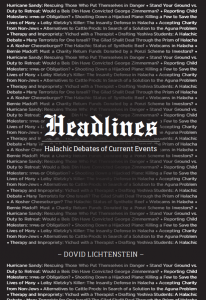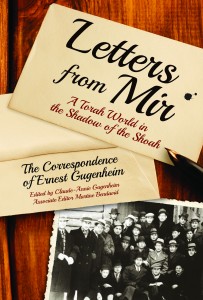New Books from OU Press
 Headlines: A Halachic Debate of Current Events
Headlines: A Halachic Debate of Current Events
By Dovid Lichtenstein
OU Press
Orthodox Jews are no strangers to controversy. Media attention, welcome or otherwise, is a regular feature of life for our community and provides rich material for debate and discussion, both in our real-life interactions as well as in our virtual ones. In these debates—whether the topic is a new technology previously unimagined or the proper course of action in a difficult situation—the question is often what halachah has to say about a given issue.
In Headlines, Dovid Lichtenstein, a successful businessman who is also an accomplished talmid chacham, uses these news items as a starting point for impressively researched halachic analyses of contemporary questions that have come to the forefront of discussion in our community and beyond. Employing the classical yeshivah method of learning, combined with clear language and a broad range of sources, he finds relevant halachic analogues for new situations, often discovering original parallels to cases discussed in classic sources. The author’s approach moves us away from the pitfall of deciding contentious issues on the basis of passion alone. Instead, this book provides halachic sources and arguments as the basis for its conclusions. The reader may agree or disagree with the author’s conclusions, but the discussions will surely provide a helpful halachic framework for further consideration of the issues. A small sample of issues discussed in this wide-ranging book: Is there an obligation to rescue people who ignored evacuation warnings during Hurricane Sandy? Is one forbidden or obligated to report suspected child molesters? How can we solve the problem of recalcitrant husbands and agunot? What is the halachic status of lab-created beef? In discussing these and many other issues, the author fulfills the vision he sets forth in his introduction for Torah Judaism which does not separate from the world but makes use of its wisdom to engage with it.
 Letters from Mir: A Torah World in the Shadow of the Shoah
Letters from Mir: A Torah World in the Shadow of the Shoah
By Ernest Gugenheim
Edited by Claude-Annie Gugenheim and Martine Bendavid
OU Press
In 1938, Ernest Gugenheim, a young French rabbi, arrived in the shtetl of Mir, coming from across a continent and a cultural barrier to study in the Mir Yeshiva. This book, comprised of the letters Rabbi Gugenheim wrote home to his family and friends, allows us a rare glimpse of a world that was.
Rabbi Gugenheim’s letters are spellbinding; engaging and humorous, they bring the readers into his experiences with the warmth, intimacy and honesty of family correspondence. The book is filled with vignettes which capture the perspective of a Westerner newly confronting the Eastern European world. In his first letter home, he describes his initial encounter with the Mir beit midrash:
Now, make a small effort of imagination to conjure up what is to follow: It is ten-thirty in the evening, and we approach the yeshiva. We first hear from outside a chanting sound, or rather it is louder than chanting, but really this is nothing as yet. We enter, and, lo, an immense room, truly immense, and inside there are let us say fifty to a hundred fellows, masmidim, who sing, who shout, who move and shake in a frenzy that delights and frightens you at the same time. [This] was only a small portion of the students present because it was not the time of the lehrnen; what will it be like when everyone is here?
In addition to his lyrical descriptions of yeshivah life, the letters contain accounts of daily life in Mir, where the poverty of the residents stood in stark contrast to the living conditions of the relatively affluent foreign students. Life was not totally gloomy, however. One letter describes the efforts of the local girls to be noticed by the yeshivah boys:
Every day, and especially on Shabbos, the “Jewlettes” stroll along the “main street” in the latest fashions (of Mir, to be sure), but in colors altogether exotic, yellow, green, red, and that can be seen from a distance. They are capable of strolling in this way 50 or 100 or 1000 times on a Shabbos afternoon.
Rabbi Gugenheim served as a chaplain in the French army during World War II, was captured, and spent the war in a P.O.W. camp. He went on to become a prominent rabbinical leader of the French Jewish community.
Letters from Mir is a unique portrait of a fascinating individual and his times.
